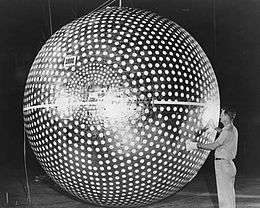Explorer 9
Explorer 9, known as S-56A before launch, was an American satellite which was launched in 1961 to study the density and composition of the upper thermosphere and lower exosphere.[2] It was a reflight of the failed S-56 mission, and consisted of a 7-kilogram (15 lb), 3.7-meter (12 ft) balloon which was deployed into a medium Earth orbit.[3] The mission was conducted by NASA's Langley Research Center.
 Explorer 9 before launch | |
| Mission type | Air density |
|---|---|
| Operator | NASA |
| Harvard designation | 1961 Delta 1 |
| COSPAR ID | 1961-004A |
| SATCAT no. | 81 |
| Start of mission | |
| Launch date | 16 February 1961, 13:05:00 UTC |
| Rocket | Scout X-1 ST-4 |
| Launch site | Wallops LA-3 |
| End of mission | |
| Decay date | April 9, 1964 |
| Orbital parameters | |
| Reference system | Geocentric |
| Regime | Medium Earth |
| Perigee altitude | 635 kilometers (395 mi) |
| Apogee altitude | 2,581 kilometers (1,604 mi) |
| Inclination | 38.8 degrees |
| Period | 118.4 minutes |
| Epoch | 16 February 1961, 08:12:00 UTC [1] |
Explorers | |
Spacecraft design
The spacecraft consisted of alternating layers of aluminium foil and Mylar polyester film. Uniformly distributed over the aluminium surface were 5.1 cm-diameter dots of white paint for thermal control. The sphere was packed in a tube 21.6 cm in diameter and 48.3 cm long and mounted in the nose of the fourth stage of its Scout X-1 launch vehicle.[4]
Mission
Explorer 9 was launched from Launch Area 3 at the Wallops Flight Center, atop a Scout X-1 rocket with the serial number ST-4. It was the first spacecraft launched from Wallops Island to achieve orbit, with one previous attempt having failed. The launch occurred at 13:05:00 UTC on 16 February 1961, and resulted in Explorer 9 being deployed into an orbit with an apogee of 2,581 kilometres (1,604 mi), a perigee of 635 kilometres (395 mi), 38.8 degrees of inclination and a period of 118.4 minutes.[5] It was assigned the Harvard designation 1961 Delta 1.[6]
Upon separation of the fourth stage, the sphere was inflated by a nitrogen gas bottle, and a separation spring ejected it out into its own orbit. The two hemispheres of aluminium foil were separated with a gap of Mylar at the spacecraft's equator and served as the antenna. A 136 MHz, 15 mW beacon was carried for tracking purposes, but the beacon failed on the first orbit and the SAO Baker-Nunn camera network had to be relied upon for tracking. Power was supplied by solar cells and rechargeable batteries.
The second of six identical air density research satellites to be launched, Explorer 9 was the first to successfully reach orbit. It was still operational when the next satellite in the series, Explorer 19, was launched, allowing simultaneous readings to be taken and compared.[4]
Mission results
Careful and continuous photographic observation of the satellite allowed scientists to conduct an unprecedented survey of the Earth's exosphere. The satellite first confirmed the daily bulge in the upper atmosphere caused by the sun's heating the air during the day and verified the model of exospheric temperature developed according to other satellite data.[7] It was later discovered that the temperature of the exosphere increased after geomagnetic disturbances in the ionosphere, peaking around five hours after each event. [8] With three years of data, scientists were able to discern a seasonal variation to the exosphere's density, with an increase of 25% observed in winter over summer at a reference latitude of 39 degrees. The delay in the temperature increase resulting from magnetic disturbances was further refined to 5.2 ± .4 hours.[9]
Explorer 9 decayed from orbit on 9 April 1964.[5]
Legacy
A replica of the spacecraft, possibly a flight backup, is currently located in the Smithsonian Institution's National Air and Space Museum, although it is not on display.[10]
References
- "NASA - NSSDCA - Spacecraft - Trajectory Details". nssdc.gsfc.nasa.gov. Retrieved 2018-04-30.
- Smith, Woody. "Explorer Spacecraft Series". NASA History Division. Retrieved 17 June 2010.
- Wade, Mark. "S-56". Encyclopedia Astronautica. Retrieved 17 June 2010.
- Krebs, Gunter. "Explorer: AD". Gunter's Space Page. Retrieved 21 Dec 2018.
- McDowell, Jonathan. "Satellite Catalog". Jonathan's Space Page. Retrieved 17 June 2010.
- McDowell, Jonathan. "Launch Log". Jonathan's Space Page. Retrieved 17 June 2010.
- "Preliminary Analysis of the Atmospheric Drag of the Twelve-Foot Balloon Satellite (1961 δ1)". Retrieved 21 Dec 2018.
- "Analysis of the Atmospheric Drag of the Explorer IX Satellite from Precisely Reduced Photographic Observations". Retrieved 21 Dec 2018.
- "Atmospheric Densities and Temperatures from Precisely Reduced Observations of the Explorer IX Satellite". Retrieved 21 Dec 2018.
- "Satellite, Explorer 9, Balloon Replica". Retrieved 21 Dec 2018.
.png)